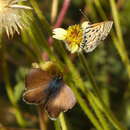en
names in breadcrumbs


Frequent
Azanus jesous is very active, and always fly very low, just above the grasses. It nectar eagerly at any available wild flowers and fixedly keep their wings held erect when feeding.
Size: 18-24 mm. Azanus jesous is small blue and finely-marked butterfly . Male has transparent shiny blue scales on the upperside of the wing, allowing darker areas of the underside of the wing to show through, and giving it a striped appearance; the underside of the wing is a delicate violet-blue, and it has lilac-blue wings with black margins.The upperside of the wing in female is mostly brown with dusting of pale blue scales towards wing bases, and also have a variable, white, disc-shaped patch, an obvious brown spot near the tips, and a black spot near the body. The undersides of the wings on both male and female have broad, straight, white-edged bands on the forewings and a group of white-edged, brown spots on the hindwings.
Sinai. Larsen (1990) suggests probably Gebel Elba as well. AOO = 38 km2. EOO = 156,000 km2. 3 locations.
Widespread (most of dry Africa, Egypt, Syria, Ceylon, India, Burma, across the entire African continent including Madagascar, and in Asia from Pakistan, India and Sri Lanka to Burma).
Adults fly very actively around acacia, settling suddenly; males come readily to bird droppings and wet soil. This species is found in dry grassy habitats ranging from deserts, steppes, savannahs and thorn scrub, to clearings in the drier forests.
Not Assessed ( not an Egyptian resident)
Two generations per year.
9 known records. Latest in 2001 (from South Sinai)
Larsen (1990) suggests it is a migrant
February-October
Not known any threats .
Host-plants: Acacia species, Prosopis farcta (Leguminosae).